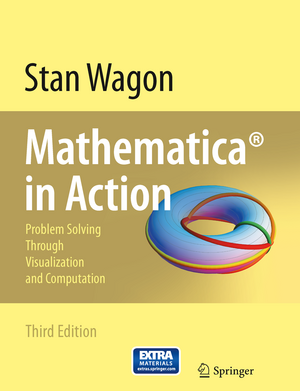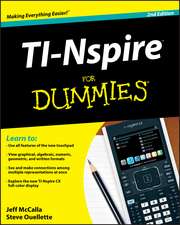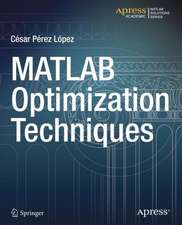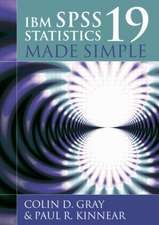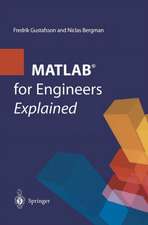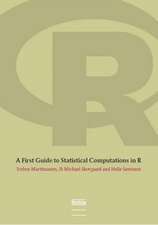Mathematica® in Action: Problem Solving Through Visualization and Computation
Autor Stan Wagonen Limba Engleză Paperback – 11 iun 2010
Preț: 541.09 lei
Preț vechi: 636.57 lei
-15% Nou
Puncte Express: 812
Preț estimativ în valută:
103.56€ • 109.25$ • 86.30£
103.56€ • 109.25$ • 86.30£
Carte tipărită la comandă
Livrare economică 02-16 ianuarie 25
Preluare comenzi: 021 569.72.76
Specificații
ISBN-13: 9780387753669
ISBN-10: 0387753664
Pagini: 578
Ilustrații: XI, 580 p. With online files/update.
Dimensiuni: 210 x 279 x 33 mm
Greutate: 1.38 kg
Ediția:3rd ed. 2010
Editura: Springer
Colecția Springer
Locul publicării:New York, NY, United States
ISBN-10: 0387753664
Pagini: 578
Ilustrații: XI, 580 p. With online files/update.
Dimensiuni: 210 x 279 x 33 mm
Greutate: 1.38 kg
Ediția:3rd ed. 2010
Editura: Springer
Colecția Springer
Locul publicării:New York, NY, United States
Public țintă
GraduateCuprins
A Brief Introduction.- Plotting.- Prime Numbers.- Rolling Circles.- Three-Dimensional Graphs.- Dynamic Manipulations.- The Cantor Set, Real and Complex.- The Quadratic Map.- The Recursive Turtle.- Parametric Plotting of Surfaces.- Penrose Tiles.- Complex Dynamics:Julia Sets and the Mandelbrot Set.- Solving Equations.- Optimization.- Differential Equations.- Computational Geometry.- Check Digits and the Pentagon.- Coloring Planar Maps.- New Directions For ?.- The Banach–Tarski Paradox.- The Riemann Zeta Function.- Miscellany.
Recenzii
From the reviews of the third edition:
This book is a pleasing potpourri of Mathematica showpieces, picked to show the value of Mathematica for mathematics teaching and investigation... Although there is an introductory chapter explaining Mathematica, it is just enough to get you oriented and the examples go far beyond anything in this introduction. This book may motivate you to learn Mathematica but it won’t teach it to you.
The book is full of interesting things. The first half focuses on visualization and the math is relatively elementary (nothing beyond multivariable calculus). The second half works on much harder problems. —MAA Reviews
“Beginners will benefit from the book as will more experienced Mathematica programmers as the explorations build from simple introductory concepts … . The best feature of the book is that it teaches via interesting examples. … The writing is remarkably good. … The book contains a good number of color illustrations and is rich in Mathematica output. … interesting explorations with clear and engaging writing are hard to come by. I’m delighted to have this book in my collection.” (Playing with Mathematica, June, 2011)
Mathematica in Action is not a guidebook nor a reference manual. It is best described as a project book full of ideas and inspiration for research projects for anyone from high school students to professional mathematicians. It combines real mathematics with sophisticated coding… I highly recommend Mathematica in Action, both for its mathematical content and for its Mathematica content. You don’t have to be a serious Mathematica user to enjoy this book or even use it. You can read it for mathematical ideas and inspiration without touching a keyboard, or, if you are a devotee of a different software system, you might be inspired to translate the examples into your favorite language. —The MathematicalAssociation of America, September, 2011
“This the third edition of the famous book ‘Mathematica in Action’ in which the author guides beginner as well as veteran users alike through Mathematica’s powerful tools for mathematical exploration … .” (T. C. Mohan, Zentralblatt MATH, Vol. 1198, 2010)
This book is a pleasing potpourri of Mathematica showpieces, picked to show the value of Mathematica for mathematics teaching and investigation... Although there is an introductory chapter explaining Mathematica, it is just enough to get you oriented and the examples go far beyond anything in this introduction. This book may motivate you to learn Mathematica but it won’t teach it to you.
The book is full of interesting things. The first half focuses on visualization and the math is relatively elementary (nothing beyond multivariable calculus). The second half works on much harder problems. —MAA Reviews
“Beginners will benefit from the book as will more experienced Mathematica programmers as the explorations build from simple introductory concepts … . The best feature of the book is that it teaches via interesting examples. … The writing is remarkably good. … The book contains a good number of color illustrations and is rich in Mathematica output. … interesting explorations with clear and engaging writing are hard to come by. I’m delighted to have this book in my collection.” (Playing with Mathematica, June, 2011)
Mathematica in Action is not a guidebook nor a reference manual. It is best described as a project book full of ideas and inspiration for research projects for anyone from high school students to professional mathematicians. It combines real mathematics with sophisticated coding… I highly recommend Mathematica in Action, both for its mathematical content and for its Mathematica content. You don’t have to be a serious Mathematica user to enjoy this book or even use it. You can read it for mathematical ideas and inspiration without touching a keyboard, or, if you are a devotee of a different software system, you might be inspired to translate the examples into your favorite language. —The MathematicalAssociation of America, September, 2011
“This the third edition of the famous book ‘Mathematica in Action’ in which the author guides beginner as well as veteran users alike through Mathematica’s powerful tools for mathematical exploration … .” (T. C. Mohan, Zentralblatt MATH, Vol. 1198, 2010)
Textul de pe ultima copertă
In this third edition of Mathematica® in Action, award-winning author Stan Wagon guides beginner and veteran users alike through Mathematica's powerful tools for mathematical exploration. The transition to Mathematica 7 is made smooth with plenty of examples and case studies that utilize Mathematica's newest tools, such as dynamic manipulations and adaptive three-dimensional plotting. Mathematica in Action also emphasizes the breadth of Mathematica and the impressive results of combining techniques from different areas. This material enables the reader to use Mathematica to solve a variety of complex problems.
Case studies ranging from elementary to sophisticated are provided throughout. Whenever possible, the book shows how Mathematica can be used to discover new things. Striking examples include the design of a road on which a square wheel bike can ride, the design of a drill that can drill square holes, an illustration of the Banach—Tarski Paradox via hyperbolic geometry, new and surprising formulas for p, the discovery of shadow orbits for chaotic systems, and the use of powerful new capabilities for three-dimensional graphics. Visualization is emphasized throughout, with finely crafted graphics in each chapter.
Wagon is the author of eleven books on mathematics, including A Course in Computational Number Theory, named one of the ten best math books of 2000 by the American Library Association. He has written extensively on the educational applications of Mathematica, including the books VisualDSolve: Visualizing Differential Equations with Mathematica, and Animating Calculus: Mathematica Notebooks for the Laboratory.
From reviews of the second edition:
"In a dazzling range of examples Stan Wagon shows how such features as animation, 3-dimensional graphics and high-precision integer arithmetic can contribute to ourunderstanding and enjoyment of mathematics."
—Richard Walker, The Mathematical Gazette
"The bottom line is that Mathematica in Action is an outstanding book containing many examples of real uses of Mathematica for the novice, intermediate, and expert user."
—Mark McClure, Mathematica in Education and Research
Case studies ranging from elementary to sophisticated are provided throughout. Whenever possible, the book shows how Mathematica can be used to discover new things. Striking examples include the design of a road on which a square wheel bike can ride, the design of a drill that can drill square holes, an illustration of the Banach—Tarski Paradox via hyperbolic geometry, new and surprising formulas for p, the discovery of shadow orbits for chaotic systems, and the use of powerful new capabilities for three-dimensional graphics. Visualization is emphasized throughout, with finely crafted graphics in each chapter.
Wagon is the author of eleven books on mathematics, including A Course in Computational Number Theory, named one of the ten best math books of 2000 by the American Library Association. He has written extensively on the educational applications of Mathematica, including the books VisualDSolve: Visualizing Differential Equations with Mathematica, and Animating Calculus: Mathematica Notebooks for the Laboratory.
From reviews of the second edition:
"In a dazzling range of examples Stan Wagon shows how such features as animation, 3-dimensional graphics and high-precision integer arithmetic can contribute to ourunderstanding and enjoyment of mathematics."
—Richard Walker, The Mathematical Gazette
"The bottom line is that Mathematica in Action is an outstanding book containing many examples of real uses of Mathematica for the novice, intermediate, and expert user."
—Mark McClure, Mathematica in Education and Research
Caracteristici
Examples and case studies utilize Mathematica 7's newest tools, such as dynamic manipulations and adaptive three-dimensional plotting. Emphasizes the breadth of Mathematica and the impressive results of combining techniques from different areas. Visualization is emphasized throughout, with finely crafted graphics in each chapter. All Mathematica code is included as Extras through Springer, saving the reader hours of typing. Access Extras here: http://extras.springer.com/2010/978-0-387-75366-9 Includes supplementary material: sn.pub/extras
